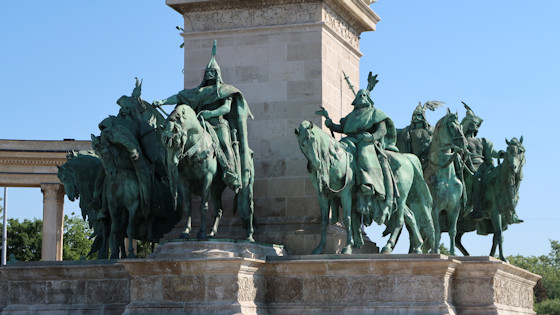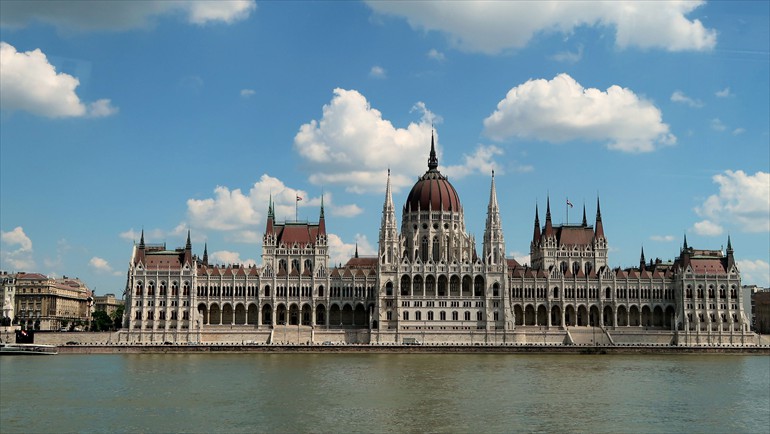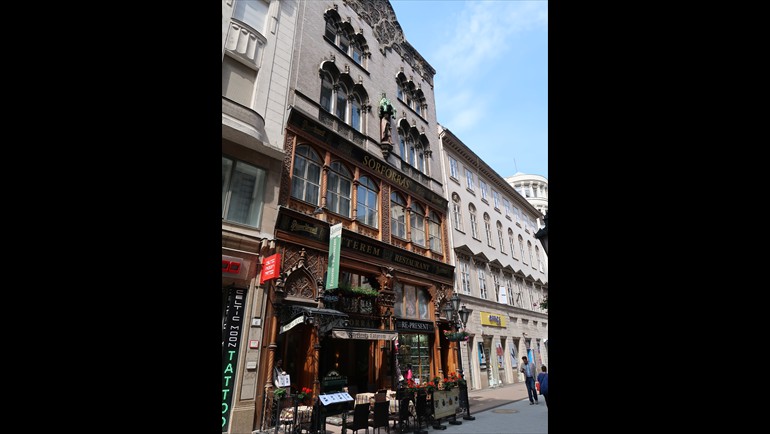Budapest, the capital of Hungary, has 2 million inhabitants. The Danube divides the city into two halves: Pest and Buda. To the west rises the Buda Castle Hill with its majestic castle and the historic castle quarter. The UNESCO declared the impressive castle hill a World Heritage Site.
We reached Budapest by boat. See the
first impressions.
History
Just like Vienna, Budapest was founded by the Romans and was called Aquincum.
In the course of the migration of the peoples, a Slavic population settled here at first, but from 896 onwards they were displaced by the Uralic peoples - the Hungarians.
Around the year 1000, Stephen I became the first king of Hungary. After an invasion of the Mongols in 1241 the royal residence was first moved to Visegrád. In 1308 the city of Budapest was renewed and in 1361 became the capital of the kingdom.
In the 16th century the Ottomans conquered Hungary. The capital of the still unoccupied part of Hungary, became Bratislava from 1536 to 1784, while Buda became the seat of a Turkish pasha.
Finally, the Habsburgs, who had been kings of Hungary since 1526, succeeded in driving out the Ottomans and reuniting Hungary. In 1780 German was introduced as an official language by the Habsburgs.
After the Hungarian Revolution of 1848 against the Habsburgs, a settlement was reached between Austria and Hungary. Thus Hungary became largely independent. Emperor Franz Joseph resided once a year in Budapest at the Buda Castle. During this time, dressed in the Hungarian language and in a Hungarian uniform, he held his Hungarian offices together with the ministers of Hungary and the Royal Hungarian Imperial Diet.
The pedestrian zone
,small but nice.
In the middle of Pest city centre, between Vörösmarty Square and the central market hall, Váci utca runs along. A part of it is a pedestrian zone.
There you can find countless shops, boutiques and the everywhere existing, well-known luxury fashion houses, but also cafés.
A little aside in the side streets there are still shops with Hungarian folk art or the famous Hungarian wines.

At the Elisabeth Bridge on the Danube on the Pest side is the Liebfrauenkirche (parish church).
The church is said to stand on the place where the patron saint of the town, St. Gellért, was buried.


The outside of the baroque church shows Gothic ribbed vaults, classicistic elements and a Gothic altar inside. I was particularly surprised by the statue of Saint Thérèse of Lisieux. It is exactly this model of the statue that I encountered a hundred times as a pilgrim to St. James in France.

At the other side of the Elisabeth Bridge (in Buda), this Sisi monument is located in a small park.
Fishermen's Bastion
Every tourist comes to the Fishermen's Bastion at some point. It is located in the Buda Castle District on a hill above the Danube. The name is said to come from the guild of Danube fishermen, who held their market here in the Middle Ages and had to defend this part of the city wall. The present Fishermen's Bastion was built at the end of the 19th century in the neo-Romanesque style. Its pointed stone towers symbolise the seven tribal leaders of the Hungarians.
In front of the bastion there is a bronze equestrian statue of King Stephen I the Saint, who spread Christianity in Hungary.

On the Heroes' Square in the district of Pest, the Millennium and Heroes' Monument is located, surrounded by colonnades. On the left and right side there are art museums.

The Millennium Monument commemorates the heroes of Hungarian history. In the centre there is a 36-metre-high column that carries an approximately five-metre-high figure of the archangel Gabriel. He holds the Hungarian crown in one hand and the apostolic double cross in the other. According to the legend, the archangel is said to have appeared in the Pope's dream and proposed to him to give the already prepared royal crown to the Hungarian people. At the foot of the column you can find the equestrian statues of the seven tribal princes.

Danube Cruise
























